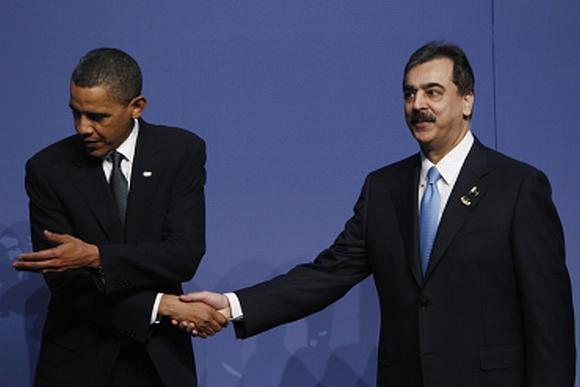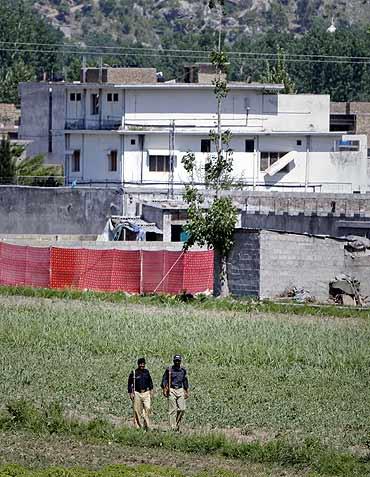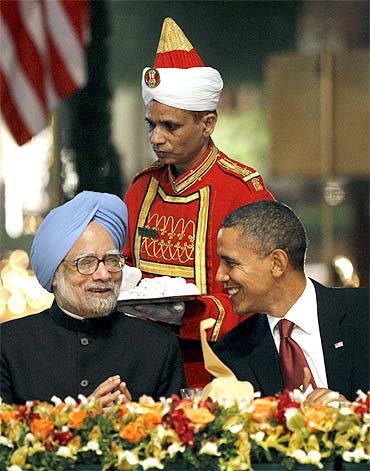
While the United States deals with India as an Indian Ocean and Pacific Ocean power, it deals with Pakistan and countries to the West as part of Middle East, says Col Anil Athale.
The fading 2011 saw winding down of the war in Iraq. The situation is far from normal and there is a lingering doubt about the durability of the new regime, and anxieties (for Western powers) about the drift of the Shia dominated regime towards Iran. Yet the world headlines were indeed dominated by the happenings on the Western fringes of the Indian Subcontinent, ie the AfPak region.
'The Killing Fields' of AfPak were in news almost throughout the year. The year also began on a positive note for Indo-US relations as the euphoria generated by end of the year (2010) visit by President Obama generated much hope and hype.
But despite these trends, the year 2011 will be remembered for two nonevents;
Despite the armed clashes between the United States and Pakistan forces, the US-Pak alliance did not break.
In spite of many high-level visits and lot of rhetoric, the Indo-US partnership failed to takeoff.
...

It is nothing short of a political 'miracle' that the two belligerents remain formal allies. The miracle can only be understood in the backdrop of history and unstated 'interests' that keep them together.
The US-Pak alliance was always opportunistic; while the two allies shared the same bed, they both dreamt different dreams. In the Cold War era, the US needed bases to contain Communist Russia and China (till the Shanghai declaration of 1972 singed by Nixon and Chao En Lie). The US also needed the Pak army as its mercenary force in the Middle East, sort of boots on ground at discounted price. Pak milked the alliance to get arms and tech to neutralise ten times bigger India.
Pakistan considers itself the heir to the Mughal Empire (that ruled over most of North and Central India) and its India centric approach reflects this myth. Anti-Indianism is embedded in its genes and genesis. Thus its using US (and now China) to balance India in military and nuclear field was logical.
The inherent contradictions in this marriage of convenience came to fore forcefully in 2011. Post Zia an 'Islamised' Pak army is no longer the reliable mercenary force that the Americans wanted. The double game played in Afghanistan is a reflection of this reality as much as Pak's dream of having Afghanistan under its thumb as 'Strategic depth'.
This author cannot resist the comment on absurdity of this proposition! You create depth by having an obstacle/buffer in front, not in the rear! The mood on the Pak streets is even worse, as the US has now replaced India as the prime 'hate' nation. Thus a democratic Pakistan would be an even bigger thorn for the Americans.
...

The year began with the killing of three Pakistanis in Lahore by an American contractor Raymond Davis on January 28. The street protests in Pakistan, already in vogue since the sentencing for 86 years of an allegedly rouge scientist Ms Affia Sidiqa by American courts in the previous year. The near rupture in relations over this affair was avoided when after paying 'blood money' Davis was acquitted on October 3 and repatriated to the US.
The contrast between Affia case and Davis affair was too stark for even the most docile Pakistanis to accept. Then on May 2, 2011, the American Navy Seals launched a successful raid near Pakistani Military Academy in Abbotabad and killed Osama Bin Laden.
The Americans suffered their biggest setback in the ten-year war in Afghanistan when on August 6, 2011, allegedly Taliban shot down two American helicopters killing amongst others 22 Navy Seal Commandos of Team 6 that had raided Abbotabad earlier.
Though the Americans have not publicised the event, one can only surmise that it was a 'revenge' attack for killing of OBL in May. Worse was to follow when on 26/11 (anniversary of Mumbai attack) NATO forces attacked a Pakistani post on the Afghan border with helicopter gunships for over two hours and killed 28 Pakistan soldiers.
As an aside, even in the worst days of Indo-US tensions in 1971, Indian and American soldiers never came to face each other -- though during an Indian attack on Shakkargarh town an American Brigadier escaped being captured by the Indians in the nick of time.
It is indeed the strangest military alliance where the allies seem to regularly kill each other's soldiers.
What then explains this strange alliance? It seems that the glue that binds US-Pak in an alliance is the abiding American interest in Saudi Arabia and its oil. The Saudis on the other hand see the Pakistan army as its last resort if faced with its own people (especially, Shia citizens) and an 'Arab Spring' like street uprising.
Iran and its nuclear ambition make the Saudi even more nervous than Israel. Pakistan's nuclear arsenal, built with Saudi funding, is seen as a hedge against that threat. Thus, today it seems that it is Saudi Arabian interest and influence in Pakistan that constrains Americans in breaking with Pakistan.
Will modern American arms continue to flow to Pakistan, either directly or through oil-rich Arabs, is a million dollar question that has no easy answers. Till such time as this complicated relationship remains intact, Indo-US partnership will continue to face difficulties.
...

On December 16 this year, incidentally, the 40th anniversary of India's victory in the Bangladesh war, this author attended a talk by US Deputy Secretary of State, William J Burns at Pune. The American diplomat waxed eloquent on the emerging Indo-US relationship in an 'Asia Pacific Century' and felt that the relationship had crossed a major threshold. Careful to stress that this was not for containment of China, the deputy secretary left it unsaid that it was all the same important to 'balance' China.
But here again both the countries have to face major contradictions in interests in the Middle East. While in the Asia Pacific, the Indo-US interests indeed do converge, that is not the case in the Middle East. There are major differences between the two on Iran and Palestinian issue as well as continued building up of Pakistan military by the US.
This author pointed out that during the last 20 years of interaction with the US, one has been pointing out this problem. The American view has been institutionalised by the fact that the boundaries of American Centcom and Pacific Command areas of responsibility lie along the Indo-Pak border. Thus while the US deals with India as an Indian Ocean and Pacific Ocean power, it deals with Pakistan and countries to the West as part of Middle East.
When pointed out that this contradiction has existed for the last 60 years and complicates the Indo-US partnership, the diplomat chose to brazen it out. More than even the nuclear issue, where the progress has been very slow, this fundamental divergence has kept the Indo-US relations from progressing further.
In the coming year as US disengages from Afghanistan, this friction may reduce, but will never go away. These longstanding geo-political contradictions explain the nonevent of Indo-US partnership remaining still a 'work in progress' in 2011.